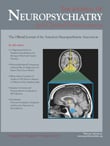Mirtazapine-Associated Urinary Retention
To the Editor: Mirtazapine, an efficacious antidepressant of dual noradrenergic and serotoninergic mechanisms of action, is deemed particularly safe and well tolerated, especially with respect to its urinary side effects, owing to its very weak muscarinic anticholinergic properties. 1 Moreover, it has been found to ameliorate l -dopa-induced dyskinesias in patients with Parkinson’s disease. 2 Its safety in this respect makes it an attractive choice for the treatment of depression in elderly male patients with normal age-related prostate hypertrophy and concomitant Parkinson’s disease, whereby the possibility of incomplete voiding cannot be excluded. 3 To the best of our knowledge there are as yet no available reports on mirtazapine’s potential to induce urinary retention in this patient population. In the following we report on such a case, whereby the administration of low-dose mirtazapine resulted in the patient’s urinary retention.
Case Report
This is the case of an 85-year-old man with asymptomatic age-related benign prostate hypertrophy since the age of 77 and a 3-year history of Parkinson’s disease, for which he underwent a treatment with a compound of l -dopa, carbidopa, and entacapone at the dosage of 200/50/800 mg/day, respectively, equally divided in four doses. Moreover, for the last few months, the patient exhibited symptoms of a major depressive episode of mild severity according to DSM-IV diagnostic criteria, for which he had been prescribed mirtazapine, 15 mg/day. However, within 24 hours after mirtazapine’s initiation, he suffered from acute urinary retention necessitating the insertion of a Foley catheter. Mirtazapine was immediately discontinued, and his urinary retention subsided within 24 hours. The same pattern reemerged upon a second trial of mirtazapine a week later. Afterward, the patient was prescribed citalopram, 20 mg/day, without any urinary side effects. In the course of the following year, his previously mentioned antiparkinsonian medication was progressively increased to 400/100/800 mg/day without recurrence of urinary retention.
Discussion
Although urinary retention may occur spontaneously in patients with benign prostate hypertrophy, the repeated pattern of its conditional dependence on mirtazapine administration renders this hypothesis in our case highly unlikely.
With respect to the mechanisms of mirtazapine-induced urinary retention, we should note that descending norepinephrine and 5-hydroxy-tryptamine (5-HT) pathways from the brain to the ventral horn of the sacral spinal cord, in the presence of the neurotransmitter glutamate, enhance pudendal nerve activity and thus increase smooth urethral sphincter muscle contraction. 4 Moreover, stronger norepinephrine than 5-HT reuptake inhibition may induce increased peripheral stimulation of norepinephrine receptors in the smooth urethral muscle, causing urinary hesitancy or even retention. On this score, we should be reminded of reboxetine’s—a selective norepinephrine reuptake inhibitor—potential to induce urinary hesitancy or even retention. 5 Therefore, although rare, urinary retention is a possible adverse event of antidepressant treatment with mirtazapine. Accordingly, clinicians should be aware of mirtazapine’s potential to induce urinary retention, especially in elderly male patients with asymptomatic age-related benign prostate hypertrophy.
1. Fawcett J, Barkin RL: Review of the results from clinical studies on the efficacy, safety, and tolerability of mirtazapine for the treatment of patients with major depression. J Affect Disord 1998; 51:267–285Google Scholar
2. Meco G, Fabrizio E, Di Rezze S, et al: Mirtazapine in L-dopa-induced dyskinesias. Clin Neuropharmacol 2003; 26:179–181Google Scholar
3. Hahn K, Ebersbach G: Sonographic assessment of urinary retention in multiple system atrophy and idiopathic Parkinson’s disease. Mov Disord 2005; 20:1499–1502Google Scholar
4. Viktrup L, Pangallo BA, Detke MJ, et al: Urinary side-effects of duloxetine in the treatment of depression and stress urinary incontinence. Prim Care Companion J Clin Psychiatry 2004; 6:65–73Google Scholar
5. Kasper S, Wolf R: Successful treatment of reboxetine-induced urinary hesitancy with tamsulosin. Eur Neuropsychopharmacology 2002; 12:119–122Google Scholar



